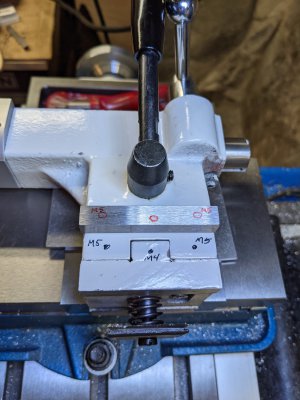- Joined
- Dec 18, 2019
- Messages
- 6,536
Thought I'd make a differential screw adjustment for my tailstock horizontal position adjustment. My tailstock is out of adjustment and I find it to be incredibly difficult to accurately adjust it. This is for a mini-lathe, which seemingly has been designed for maximum inconvenience in adjustment. My tailstock has shifted to about 0.5 mm offset right now, which has made it unusable.
My idea was to use a 9.5mm x 9.5mm x 62.5mm steel bar that spanned the tailstock casting. The end screws would be 5mm. The bar would have the end holes drilled for clearance for 5mm. The casting would be drilled and tapped for 5mm x 0.8 screws. The center hole would be tapped for 5mm x 0.8 in the bar, and 4mm x 0.7 in the casting. I would need to machine (single point thread) an M4 x 0.7 thread onto and existing M5 x 0.8 screw. This would give me 100 um of movement per revolution of the thread.
To hold the screw, I would use a 1/2" piece of round stock and thread it to M5 x 0.8. I will counterbore the head so I get a longer surface for my ER32 collet to grab. The only issue I see is how concentric I can get the screw in the rod, and the initial fit up of the assembly. And obviously, getting the metric threading done without mishaps. (I have an imperial lead screw, so I would leave the half nut engaged. Mini-lathes have no eBrake.)
Are there other gotchas that I am missing? I'd appreciate any insights. Thanks!
Picture for context.

My idea was to use a 9.5mm x 9.5mm x 62.5mm steel bar that spanned the tailstock casting. The end screws would be 5mm. The bar would have the end holes drilled for clearance for 5mm. The casting would be drilled and tapped for 5mm x 0.8 screws. The center hole would be tapped for 5mm x 0.8 in the bar, and 4mm x 0.7 in the casting. I would need to machine (single point thread) an M4 x 0.7 thread onto and existing M5 x 0.8 screw. This would give me 100 um of movement per revolution of the thread.
To hold the screw, I would use a 1/2" piece of round stock and thread it to M5 x 0.8. I will counterbore the head so I get a longer surface for my ER32 collet to grab. The only issue I see is how concentric I can get the screw in the rod, and the initial fit up of the assembly. And obviously, getting the metric threading done without mishaps. (I have an imperial lead screw, so I would leave the half nut engaged. Mini-lathes have no eBrake.)
Are there other gotchas that I am missing? I'd appreciate any insights. Thanks!
Picture for context.


